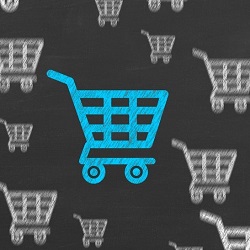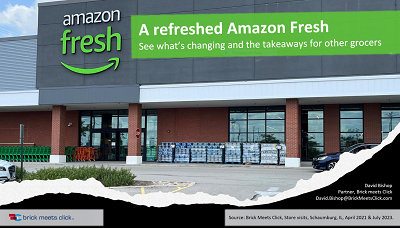Amazon Fresh: Takeaways on the shopping experience
Complete the form below to instantly download this month's dashboard.

We had the opportunity to shop the newly opened Amazon Fresh store in Naperville, Illinois on a recent Friday morning. The design and features of these new stores have received plenty of coverage, but much less has been said about the shopping experience.
Here are our topline impressions and guidance on how competitors may want to think about these stores from both online and in-store perspectives.
Overall: Dominated by online order fulfillment
While Amazon Fresh looks and feels like a typical grocery store, it appears to function more like a distribution hub for the fulfillment of online orders. At 11am on Friday, Amazon employees outnumbered regular grocery customers by 4 to 1, and most of this staff was assembling online orders for delivery.
Much of this fulfillment work was being done by two-person teams that are used when there’s a high volume of orders to fill. No doubt the teams speed up the order picking process, but they also double the number of employees in the aisle, and that can make shopping more difficult for regular shoppers.
Based on casual observation, the store appeared to be doing between 800 and 1,000 orders that day – a similar volume to what we’ve observed at the Amazon Fresh store in Schaumburg, Illinois that’s operating as a dark store and opens to the public on Thursday, January 28, 2021
This level of business suggests that each Amazon Fresh store may be taking $60,000 to $75,000 in sales per week out of the market, which makes Amazon Fresh stores a serious competitor to supermarkets in the area, especially when Prime customers get unlimited, free two-hour delivery.
Shopping experience
The customer shopping experience was very different in the perishable departments compared with the center store.
- There was plenty of staffing in all of the perishable service departments – meat, seafood, and deli (which included pizza, sandwiches and sushi) – and the product was attractively merchandised.
- Merchandising in the dry grocery and general merchandise aisles was uninspired for the most part. We’ve heard from CPG executives that coordination of the shelf planogramming was a little hectic, and it showed in the product adjacencies and limited holding power. The limited holding power was surprising given the high volume of orders assembled from shelf inventory.
- The wine aisle was the exception. There, creative shelf layouts combined with navigation signage made it easy to quickly find the variety and price point you were looking for. (Net result, we bought 4 bottles).
Pricing
A limited price check projected an inconsistent price image. Comparing Amazon Fresh prices with Aldi prices at a store located less than a mile away:
- A gallon of milk was $2.59 at Amazon Fresh and $2.65 at Aldi.
- The best price for a dozen eggs at Amazon Fresh was over $2 compared with 89 cents at Aldi.
Across the rest of the store prices seemed to mirror those found at conventional supermarkets in the same area.
In-store tech
There was plenty of digital technology available to assist consumers and improve the shopping experience.
- Electronic shelf labels communicated shelf prices, but it wasn’t always easy to read them because of their small size and low contrast.
- Help was available for locating products and answering other questions from Alexa, who could be found at several conveniently located kiosks in the store.
- The Dash Cart was available but not in wide use – no surprise, since a similar “scan and go” execution by Jewel showed that utilization was in the low single digits unless a concerted effort was made to teach customers how to use it.
BMC POV
Based on shopping this Amazon Fresh store, we’d suggest grocers think of these stores as potent online competitors that can take online market share without retailers realizing it.
As a brick and mortar competitor, however, it probably won’t win any more than its fair share of the in-store business.












